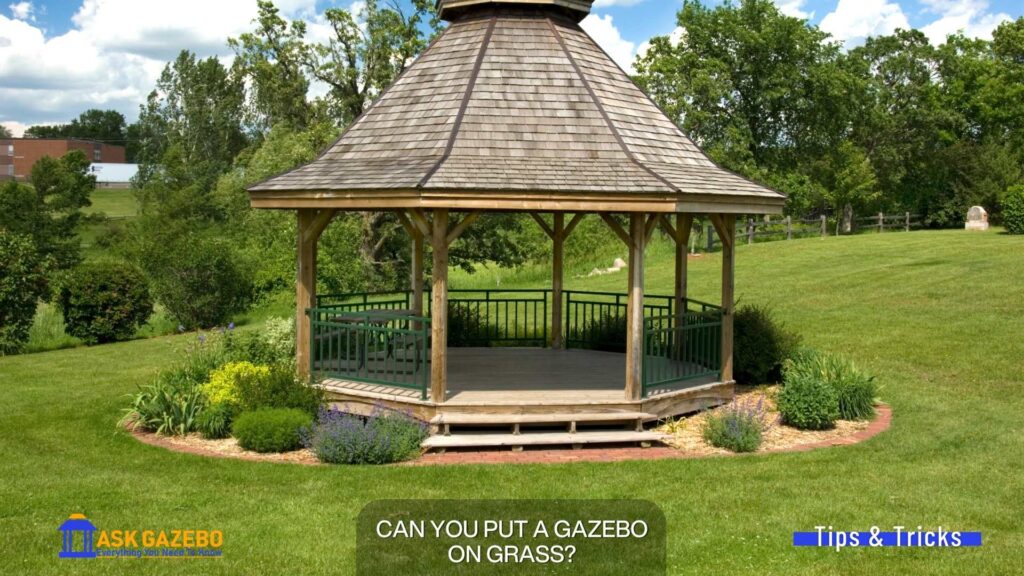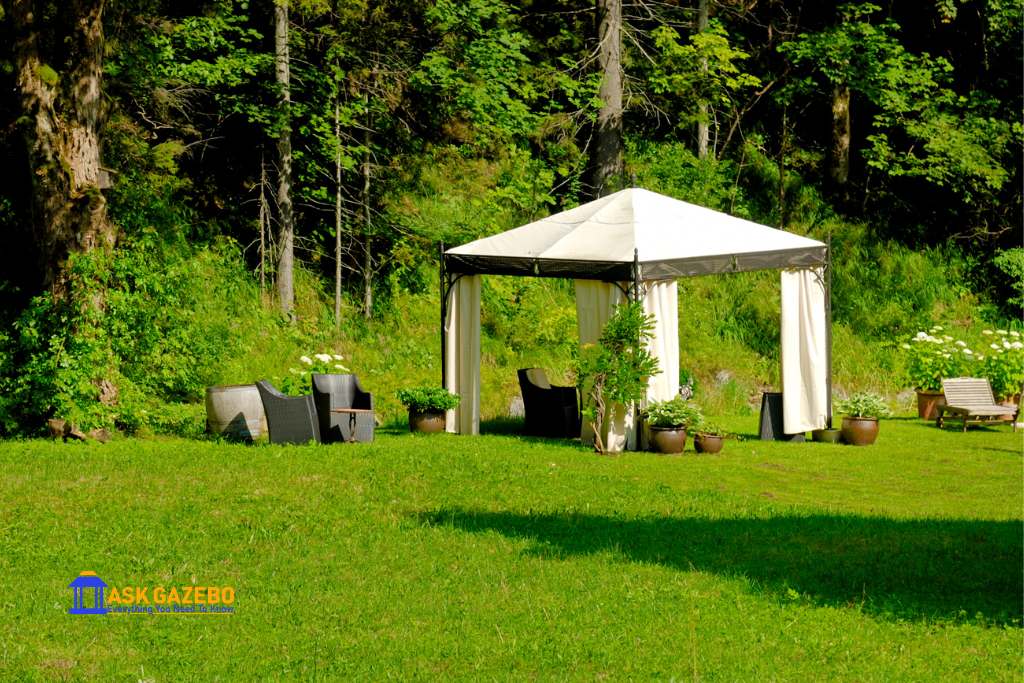So, you are planning to have a gazebo in your house and wondering if you can put a gazebo on grass? Well, wonder no more.
In this article, we will look at whether it is possible to erect a gazebo on grass and provide instructions for doing so securely and effectively.

Can you put a gazebo on the grass?
Yes, it is 100% possible to put a gazebo on the grass. But there are certain challenges as well.
The stability of the ground is an important factor when building a gazebo in the grass. Some gazebos can be rather hefty, weighing several hundred pounds or more. As a result, it is critical to confirm that the ground can hold the gazebo’s weight without shifting or sinking.
If your backyard grass is strong and established, it may be able to support the weight of a gazebo.
However, sufficient ground preparation is still required to assure the gazebo’s stability. To establish a strong base, level the ground and put a layer of compacted gravel or sand beneath the gazebo.
If your grass is thin or patchy, or the soil beneath it is prone to shifting or erosion, it may not be ideal for holding a gazebo. Alternative foundation choices may be required in certain circumstances.
Pouring a concrete slab or placing piers composed of concrete blocks or treated lumber are two choices.
Proper preparation and foundation work are essential for ensuring your gazebo’s safety and security on grass.


Subscribe For More Gazebo Videos!
Ask Gazebo
Steps for installing a gazebo on grass:
After knowing it is possible to put a gazebo on the grass in your yard, it is time to learn how to install a gazebo on the ground.
Here are the steps to follow:
Level the ground:
Before you begin assembling the gazebo, it is important to make sure that the ground is level. Use a level or a lengthy straightedge to check for any unevenness and adjust the ground as needed using soil, gravel, or sand.
Building Foundations:
While building a gazebo on the grass, building solid foundations is essential. To do so, there are two approaches:
1. Pour a concrete slab or install piers:
If the grass in your yard is thin or patchy, or if the soil beneath is prone to shifting or erosion, it is necessary to provide a more stable foundation for the gazebo.
One option is to pour a concrete slab, which will provide a solid, level surface for the gazebo. Alternatively, you can install piers made of concrete blocks or treated lumber to provide support for the gazebo.
2. Build your concrete blocks:
To make your custom-sized concrete blocks, dig four holes in the grass—one for each side’s leg. The hole should be a bit wider than the gazebo’s feet and you can dig it around 16 inches.
After this, fill them with concrete and let them dry.
Once it gets dried, you can drill the holes through the gazebo’s feet into the concrete. To make it super strong and stable, use concrete wedge anchors.
Assemble the gazebo:
Once the foundation is in place, you can begin assembling the gazebo according to the manufacturer’s instructions. This may involve attaching the frame, attaching the roof panels, and adding any additional features or accessories, such as curtains or screens.
Be sure to follow the instructions carefully and use all the necessary hardware to ensure that the gazebo is properly assembled and secure.
By following these steps, you can successfully install a gazebo on grass and enjoy the benefits of this outdoor structure in your backyard.
You might want to know how far should gazebo be from house!
How to Secure Gazebo on Grass?
There are several steps you can take to secure a gazebo on grass and ensure that it remains stable and safe. Here are some tips to follow:
Choose a suitable location:
The first step in establishing a gazebo on grass is to select an appropriate place. Look for a flat, stable plot of grass that can hold the gazebo’s weight. Place the gazebo away from slopes or regions prone to erosion or standing water.
Prepare the ground:
It is critical to prepare the ground before erecting the gazebo. To establish a strong base, follow the steps discussed above.
Follow the manufacturer’s instructions:
It is necessary to carefully follow the manufacturer’s instructions when installing the gazebo. Use all required hardware and tighten all bolts and screws securely. This will aid in the proper assembly and stability of the gazebo.
Use anchors:
If your gazebo moves easily in windy circumstances, consider using anchors to hold it to the ground. Stakes, weights, or brackets that can be affixed to the gazebo and fastened to the ground are all choices for gazebo anchors.
Regular gazebo maintenance and inspection can also assist in identifying any faults and addressing them before they become a problem.


Will a gazebo kill my grass?
A gazebo may have an effect on the grass beneath it, although it is not guaranteed that it will kill the grass. The grass dies when there is a constant load on it, and it couldn’t get much water.
For example, if you use your gazebo more often and people walk over the grass throughout the day, the grass may die.
To get the most out of your grass, follow these tips:
Water the grass:
It’s time to increase the frequency of watering your grass. You can also use any fertilizer to keep the grass in a good condition.
Examine the grass:
The state of the grass will tell you a lot about whether building a gazebo over it will impact it or not. If the grass is already weak or uneven, it may be more susceptible to damage.
Prepare the ground:
Proper ground preparation is essential for minimizing the impact of a gazebo on the grass. It will ensure the overall health of the grass in that area.
Maintenance of the grass:
Regular grass management will assist in keeping it in a healthy shape. This can involve cutting the grass surrounding the gazebo, watering it to keep it hydrated, and fertilizing it to make it grow thick and robust.
By considering these aspects, you can reduce the impact of a gazebo on your lawn and maintain it healthy and vibrant.
FAQs
Is it better to put a gazebo on a concrete slab or on grass?
It is determined by the quality of your yard’s grass and soil, as well as the weight of the gazebo. The weight of the gazebo may be supported by the grass if it is thick and well-established.
However, if the grass is thin or patchy, or if the soil is prone to moving or erosion, installing a gazebo on a concrete slab or piers may be preferable for increased stability.
Can I put a gazebo on a slope?
A gazebo should not be placed on a slope because the uneven ground can make it unstable. If your yard has a slope, it may be best to put the gazebo on a flat, level location, such as a concrete slab or piers.
Can I put a gazebo on top of an existing patio or deck?
A gazebo can usually be built on top of an existing patio or deck, as long as the structure can handle the weight of the gazebo. However, it is critical to consult with the manufacturer or an expert to confirm that the patio or deck is appropriate for this use.
Can air pull away your gazebo?
If your gazebo is not much heavy, or you haven’t secured it tight, then, yes, a heavy wind can pull away the gazebo. To avoid this, securely fix your gazebo, or use any tie-down kit to secure your gazebo.
Conclusion:
In the end, constructing a gazebo on grass can be difficult, but with little planning and patience, it is possible. Before beginning, assess the weather conditions and utilize the appropriate supplies and tools for the work.
Further, always take precautions when working around structures or machinery, and have someone on standby to assist if necessary.








